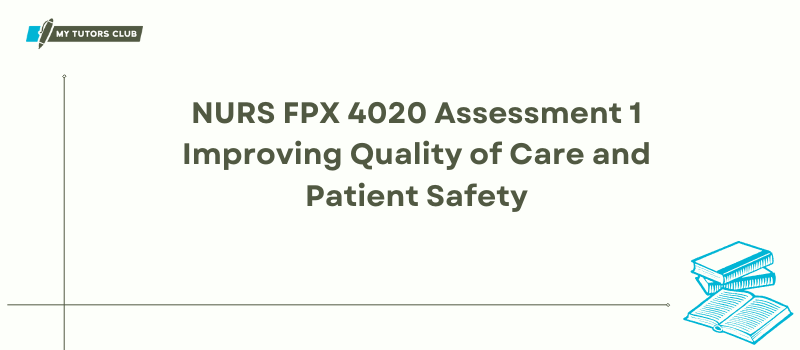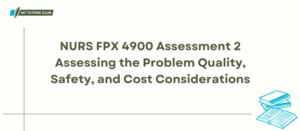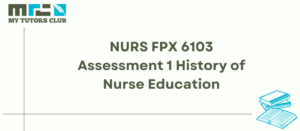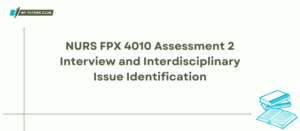NURS FPX 4020 Assessment 1 Enhancing Quality & Safety
NURS FPX 4020 Assessment 1 Improving Quality of Care and Patient Safety, Healthcare systems are continuously growing and evolving their techniques and methods to improve patient safety and satisfaction. Nurses are the core assets that primarily interact with patients and are responsible for safe medication delivery. However, medication administration errors are the major downfalls for the United States hospitals, as the Food and Drug Administration (FDA) explains the high prevalence of medication administration errors in the United States. According to the FDA, almost one lac reports are filed regarding medication administration errors, for which most responsible members are pharmacies, nurses, hospitals, and doctors (Jacobson, 2021). Therefore, it is required to put barriers on the increment of these errors to maintain patient safety and the reputation of hospitals. In this assessment, we will discuss the medication errors encountered by the women and analyze the situation to understand what went wrong.
Patient Safety
Our scenario for this assessment is based on a woman named Elena, a 35-year-old pregnant lady who came to the hospital due to high blood pressure. After monitoring her appropriately, Elena was diagnosed with severe hypertension, and nifedipine medication was prescribed to her for safe pregnancy as prescribed by clinicians after profound observation and experiences (Malha & August 2019). The health practitioners prescribed her 60mg XL dose once a day to control her blood pressure and avoid severe circumstances (MD & Ohio State University, 2022).
NURS FPX 4020 Assessment 1 Improving Quality
After a few days, Elena revisited the hospital with a severe condition which caused the doctors to immediately admit her to the emergency room after analyzing her blood pressure which was incredibly low (hypotension) and could lead to severe heart failure and pregnancy failure (Aremu, PharmD, 2021). After a thorough investigation, it was reported that even though the correct dose, the wrong dose intake impacted her life and pregnancy severely as the dose was prescribed to her two times a day. Due to the increased and wrong dose of the correct drug, the patient experiences adverse effects, which lead to a life-threatening situation. The investigation shows that this medication error was caused due to miscommunication and carelessness of nursing staff regarding double checking the dose amount due to their exhausted work routine.
Factors Contributing to Risks Concerning Patient Safety
This incident indicates the nurse’s carelessness and miscommunication factor that pertained to medication administration errors, and many researchers also emphasize these risk factors that highly contribute to such errors (Jacobson, 2021). The poor communication between patients and health providers and the low health literacy of patients also play an essential role in contributing to such events (PharmD, BCPS, et al., 2021). These factors have high severity and potential to harm the patients and cause them life-threatening events. Furthermore, due to nurses’ carelessness, patients suffer the most as they need to get hospitalized for a longer time, bear the extra medical expenses, and deal with health severity (Tsegaye et al., 2020). Patient safety is the primary concern of healthcare settings where health staff and interdisciplinary teams combined work to help produce effective patient results.
Safety by NURS FPX 4020 Assessment 1
Elena suffered a life-threatening situation because of the nurse’s negligence and carelessness regarding not attending patient safely. Nurses did not double-check the prescribed dose of the drug by doctors and informed the patient randomly, which impacted her pregnancy as well. In this situation, miscommunication or poor communication also contributed because collaboration among health staff seems to be poor in healthcare settings (Schroers et al., 2020). Due to this, nurses did not bother to double-check or communicate with doctors again regarding the prescription of doses. Furthermore, the poor medication literacy among nurses also contributed as they did not focus on the increased amount of drugs which is experimented to be safe if normal or low amount prescribed during pregnancy (Pouliot et al., 2018). Poor health literacy among nurses indicates the poor management and training of administration that leads to nurses’ negligence. However, Elena’s medication errors were caused by poor system management and a lack of safeguard factors (Gunes et al., 2020).
Evidence-Based & Best-Practice Solutions
Investigating and understanding the situation is necessary to determine which factors pertain to medication administration errors. Firstly, it is necessary to arrange training sessions for nursing staff and highlight the guidelines and best clinical practices to avoid medication administration errors and attain quality treatment (M. Tidman DHSc, & Khan, 2022). Training is necessary and required for patient safety and positive patient outcomes in healthcare settings because nurses communicate primarily with patients and doctors as they work as a bridge between them. Therefore, they must be aware of guidelines, limitations, and best practices. NURS FPX 4020 Assessment 1 Improving Quality of Care and Patient Safety.
As per Elena’s case, nurses have low health literacy, making them not realize the high dose for pregnant patients, directly impacting patient safety (M. Tidman DHSc, & Khan, 2022). According to Bengtsson et al. (2021), medication errors are linked with an interruption in work that represents the nurse’s carelessness and negligence (Bengtsson et al., 2021). Therefore, reducing interruptions and providing a safe treatment environment to patients require guiding the nurses about the severity of their minor events. Similarly, Tsegaye et al. (2020) emphasized that improving communication among healthcare staff can also positively influence mitigating the chance of medication administration errors. When nurses have high participation in communicating with health practitioners regarding prescribing, analyzing, and monitoring, there is a low probability of attempting medication administration errors (Tsegaye et al., 2020). Therefore, improving communication between health staff and patients can lead to attaining patient safety and satisfaction (Tsegaye et al., 2020).
NURS FPX 4020 Assessment 1 Improving Quality of Care and Patient Safety
In addition, to reduce patient harm through medication errors, nurses must double-check the dose amount before prescribing. According to Elena’s case, due to not double-checking the prescribed amount, Elena had to go through tough decisions and conditions. Koyama et al. (2019) also agreed over this initiative that double-checking high-risk drugs increases the effectiveness of treatment delivery and contributes to the patient’s quality safety (Koyama et al., 2019). Furthermore, with this initiative, nurses can save themselves from being involved in harsh decisions and not causing extended hospital stays, high costs, expenditures, and guilt for patients with severe conditions (Koyama et al., 2019).
For this purpose, the Barcode Medication Administration (BCMA) intervention should be utilized by hospitals to maintain their quality delivery standard and minimize human errors (Zheng et al., 2020). This is proved by evidence-based studies that BCMA reduced the ratio of medication administration errors by 43.5% in the United States (Thompson et al., 2018). Now, NURS FPX 4020 Assessment 1 Improving Quality of Care and Patient Safety. The nurses can provide medication through this advanced recognition system that alerts them regarding high doses or wrong doses to the wrong patients. This tool provides quality safety treatment and alerts the nurses regarding high-risk situations beforehand, which positively impacts the reduction of medication administration errors (Thompson et al., 2018).
Nurses Coordination Care to Increase Patient Safety
Health staff primarily focuses on delivering safe and quality treatment to patients, reducing their health expenses as well. Among health staff, the nurses are the most centered staff members whose participation can improve the hospital’s quality of treatment delivery. Russ-Jara et al. (2021) briefly discussed the nurse’s care coordination to complete the patient’s healthcare needs and requirements (Russ-Jara et al., 2021). Sharing knowledge among staff members regarding patient care and attaining a patient-centered care strategy help in providing innovative and robust ideas that contribute effectively to patient care. The collaboration ensures patient safety and transition of care and develops strong and influential personalities that lead to positive patient outcomes (Russ-Jara et al., 2021).
Effective communication and reducing interruption while working improve the organization’s environment and give them space to learn from each other. Nursing coordination also helps patients reduce their expenses by guiding them regarding the insurance plans provided by the government (Carayon & Wooldridge, 2019). When nurses coordinate effectively, the complexities start to transition into flexibilities and enable them to achieve targeted goals: patient safety and medication administration error reduction. Different approaches and strategies are taken into account, enabling interaction among them and encouraging them to guide each other in this journey (Carayon & Wooldridge, 2019).
Identifying Stakeholders
Nurses are part of the health system, so they must coordinate or collaborate with other health staff to produce effective patient outcomes. Identifying the stakeholders is vital for a better transition of care and efficient collaboration (Cho et al., 2020). The nurse educators, administrators, nurse informatics, legislative bodies, regulators, physicians, pharmacists, patients, IT experts, and researchers are the primary stakeholders with whom nurses can coordinate to reduce the impact or chances of medication administration errors (Cho et al., 2020). These stakeholders significantly contribute to attaining patient safety as patients and physicians can provide feedback regarding care delivery and initiatives that can contribute to improvement. Get NURS FPX 4020 Assessment 1 Improving Quality of Care and Patient Safety
Moreover, the IT experts and administrators involved in implementing tools like BCMA to reduce the nurse’s burden and stress that lead them towards medication errors. Double checking by pharmacists also helps the patients to get the accurate drug with the right amount, eventually contributing to patient safety (Cho et al., 2020). Researchers and legislative bodies help in providing evidence-based studies knowledge, and guidelines to perform professionally in healthcare settings. The evidence-based studies can provide complete knowledge about tackling severe conditions and situations and make nurses aware of their actions (Connor et al., 2020). Nursing informatics and nurse educators can improve nurses’ knowledge regarding the utilization of technological tools to ensure patient safety and best clinical practices.
Conclusion
In NURS FPX 4020 Assessment 1 Improving Quality of Care and Patient Safety is linked with nurses’ awareness and potential to deliver safe treatment. Medication administration errors are mainly caused by negligence and lack of knowledge that impact patient safety measures and create barriers to providing patient-centered care in healthcare settings. This assessment briefly discussed the medication error that occurred with a patient named Elena, a pregnant lady who faced life-threatening conditions due to medication errors. However, training, improving communication, and implementing BCMA can improve the healthcare setting care delivery. For this purpose, nurse coordination and collaboration are essential, and stakeholder involvement increases the impact of decisions.
References
Aremu, PharmD, F. (2021, July 16). Nifedipine: Side Effects, Dosage, Uses, and More. Healthline. https://www.healthline.com/health/nifedipine-oral-tablet#:~:text=Low%20blood%20pressure%20warning%3A%20This
Bengtsson, M., Ekedahl, A.-B. I., & Sjöström, K. (2021). Errors linked to medication management in nursing homes: An interview study. BMC Nursing, 20(1), 69. https://doi.org/10.1186/s12912-021-00587-2
Carayon, P., & Wooldridge, A. R. (2019). Improving patient safety in the patient journey: contributions from human factors engineering. Women in Industrial and Systems Engineering, 275–299. https://doi.org/10.1007/978-3-030-11866-2_12
Cho, I., Lee, M., & Kim, Y. (2020). What are the main patient safety concerns of healthcare stakeholders: A mixed-method study of web-based text. International Journal of Medical Informatics, 140(1), 104162. https://doi.org/10.1016/j.ijmedinf.2020.104162
Connor, K. I., Siebens, H. C., Mittman, B. S., McNeese-Smith, D. K., Ganz, D. A., Barry, F., Edwards, L. K., McGowan, M. G., Cheng, E. M., & Vickrey, B. G. (2020). Stakeholder perceptions of components of a Parkinson’s disease care management intervention, care coordination for health promotion and activities in Parkinson’s disease (CHAPS). BMC Neurology, 20(1). https://doi.org/10.1186/s12883-020-02011-9
Gunes, U., Efteli, E., Ceylan, B., Katip, Baran, L., & Huri, O. (2020). Medication errors made by nursing students in Turkey. International Journal of Caring Sciences, 13, 2–1183. http://www.internationaljournalofcaringsciences.org/docs/42_1_ozturk_original_13_2.pdf
Jacobson, A. (2021, May 2). Medication error statistics. The Checkup. https://www.singlecare.com/blog/news/medication-errors-statistics/#:~:text=The%20FDA%20receives%20more%20than%20100%2C000%20reports%20of%20medication%20errors
Koyama, A. K., Claire-Sophie Sheridan Maddox, Li, L., Bucknall, T., & Westbrook, J. I. (2019). Effectiveness of double checking to reduce medication administration errors: A systematic review. BMJ Quality & Safety, 29(7). https://doi.org/10.1136/bmjqs-2019-009552
M. Tidman DHSc, Dr. M., & Khan, A. (2022). Causes of medication error in nursing. Research Review, 5(1), 1753–1764. https://doi.org/10.52845/jmrhs/2022-5-1-7
Malha, L., & August, P. (2019). Safety of antihypertensive medications in pregnancy: Living with uncertainty. Journal of the American Heart Association, 8(15). https://doi.org/10.1161/jaha.119.013495
MD, K. M. R., & Ohio State University. (2022, September 20). Frequency and dosing of the long-acting anti-hypertensive agent in women with pre-eclampsia with severe features undergoing expectant management: A randomized controlled trial. Clinicaltrials.gov. https://clinicaltrials.gov/ct2/show/NCT05096728
PharmD, BCPS, P. M., MSN, RN, CNS, M. D., & PharmD, A. C. (2021). Medication administration errors. Psnet.ahrq.gov. https://psnet.ahrq.gov/primer/medication-administration-errors#:~:text=Wrong%20dose%2C%20missing%20doses%2C%20and
Pouliot, A., Vaillancourt, R., Stacey, D., & Suter, P. (2018). Defining and identifying concepts of medication literacy: An international perspective. Research in Social and Administrative Pharmacy, 14(9), 797–804. https://doi.org/10.1016/j.sapharm.2017.11.005
Russ-Jara, A. L., Luckhurst, C. L., Dismore, R. A., Arthur, K. J., Ifeachor, A. P., Militello, L. G., Glassman, P. A., Zillich, A. J., & Weiner, M. (2021). Care coordination strategies and barriers during medication safety incidents: A qualitative, cognitive task analysis. Journal of General Internal Medicine, 36(8). https://doi.org/10.1007/s11606-020-06386-w
Schroers, G., Ross, J. G., & Moriarty, H. (2020). Nurses’ perceived causes of medication administration errors: A qualitative systematic review. The Joint Commission Journal on Quality and Patient Safety, 47(1). https://doi.org/10.1016/j.jcjq.2020.09.010
Thompson, K. M., Swanson, K. M., Cox, D. L., Kirchner, R. B., Russell, J. J., Wermers, R. A., Storlie, C. B., Johnson, M. G., & Naessens, J. M. (2018). Implementation of Barcode Medication Administration to reduce patient harm. Mayo Clinic Proceedings: Innovations, Quality & Outcomes, 2(4), 342–351. https://doi.org/10.1016/j.mayocpiqo.2018.09.001
Tsegaye, D., Alem, G., Tessema, Z., & Alebachew, W. (2020). Medication administration errors and associated factors among nurses. International Journal of General Medicine, Volume 13(13), 1621–1632. https://doi.org/10.2147/ijgm.s289452
Zheng, W. Y., Lichtner, V., Van Dort, B. A., & Baysari, M. T. (2020). The impact of introducing automated dispensing cabinets, Barcode Medication Administration, and closed-loop electronic medication management systems on work processes and safety of controlled medications in hospitals: A systematic review. Research in Social and Administrative Pharmacy, 17(5). https://doi.org/10.1016/j.sapharm.2020.08.001




